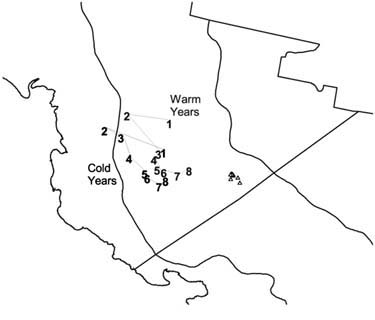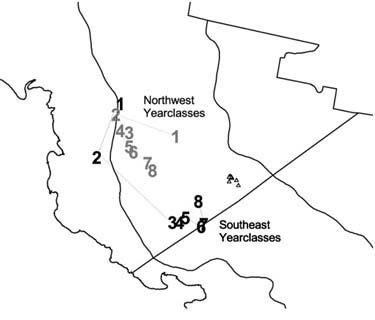|
Spatial Distribution and Ontogenetic Movement of
Walleye Pollock in the Eastern Bering Sea
Walleye pollock is a key species in the Bering Sea
and North Pacific ecosystems as well as the target
species for one of the worlds largest fisheries.
Because of its semipelagic habit and interannual
variability in distribution, the ontogenetic
movement pattern and factors influencing the spatial
distribution of this species are not well
understood. Examination of the age-specific spatial
distribution of walleye pollock in the eastern
Bering Sea (EBS) relative to physical factors and
population density may yield insights into their
ontogenetic movements, as well as their population
structure.
Bottom trawl surveys of the EBS continental shelf
have been conducted every summer since 1982.
Centroids (the mean center of abundance) were
calculated for ages 1 through 8 in every year based
on the catch-per-unit-effort (CPUE) at each station
in the standard survey area. The age-specific
centroids occur in a dispersed scatter indicating a
high degree of interannual variability in the center
of abundance across ages and years.
| |

Figure 6.. The average centroids of pollock
abundance, ages 1 through 8, for cold and warm
survey years. Triangles are centroids of
survey station distribution for each survey year.
|
Previous studies have shown that walleye pollock
avoid water below 0°C. The southern extent of cold
water over the EBS middle shelf domain is the major
influence on the mean bottom temperature encountered
during each survey. We categorized the surveys into
cold (< 2°C ), intermediate (2° - < 3°C )
and warm (>= 3°C ) years based on the mean
bottom temperature. The average centroids for
warm years are further on-shelf than the average
centroids for cold years (Figure 6) and
intermediate years, indicating that the broader
dispersal onto the shelf in warmer years was
detected by this method.
A general ontogenetic pattern of movement can be
seen in both the warm and cold years with the
average center of abundance shifting southeastward
with increasing age. However, the centroids for a
few year classes (75, 76, 77, 78, 89,
90) were shifted further southeast than the other
year classes (Figure 7 below). There may be a
relationship between low adult biomass when these
year classes were 2 year olds and the increased
southeastern shift in the distribution of walleye
pollock assessed by the bottom trawl survey. Thus,
density-dependent factors may play an important role
in the spatial distribution of a year class, in
particular, the degree to which a year class
occupies the southeastern portion of the EBS shelf.
| |

Figure 7. The average centroids of walleye
pollock abundance, ages 1 through 8, for year
classes that remain concentrated in the northwest
area of the EBS shelf and those that shift
southeastward.
|
Walleye pollock biomass is mostly supported by
occasional large year classes. The spatial
distribution of three of these large year classes (82,
89, 92) differed considerably (see
Figure 8). The 82 year class was most
dense over the northwest area of the EBS shelf. In
contrast, the 89 year class occupied the
southeast area of the shelf in high densities. The
92 year class appeared to be confined to the
northwest area of the EBS shelf with some very high
densities occurring in the northwest end of the
standard survey area. Stock assessments following
this year class over time indicate that it is either
experiencing an unusually low rate of mortality or
that fish from this year class are moving into the
sampling area. Previous simulation studies by AFSC
scientists and the shift in distribution shown in
Figure 8 seem to support the latter possibility. The
simulation study showed that the 92 year class of
pollock larvae in the EBS may have been transported
farther west than all other year classes. This
may be an indication that the initial juvenile
distribution of a year class can persist for years
and subsequently affect the observed spatial
distribution of the year class as adults.
Several considerations must be kept in mind when
viewing the results of this approach. These are
bottom trawl data and walleye pollock is a
semipelagic species. Bottom trawl selectivity
increases with age as walleye pollock become
increasingly demersal. Converting lengths to ages
can smear the true distribution of a year class,
especially for older fish where there is more
overlap in the length of different ages. We
attempted to minimize this by using separate
age-length conversions for the northwest and
southeast areas of the EBS shelf and confining our
analysis to younger ages. Border effects also need
to be considered where high densities of walleye
pollock may move out of, or into, the survey area
(as possibly has happened for the 1992 year class).
As we continue this investigation, we hope to refine
our understanding of the apparent patterns and
relationships, described above, that contribute to
the variable spatial distribution of walleye pollock.
Seasonal movements related to environmental
conditions, spawning, and feeding will also be
examined. Currently, exploratory analysis has begun
on spatial patterns of the stomach contents of
walleye pollock in the EBS.
This study was presented at the PICES X annual
meeting in Victoria, British Columbia in October
2001. The extended abstract and associated color
figures that contain more of the details of this
work can be viewed on the AFSC web site at
http://www.afsc.noaa.gov/refm/reem/doc/Pices2001Poster.pdf
Next >>>

|

|
quarterly Oct-Dec 2001 sidebar
AFSC Quarterly
Research Reports
Oct-Dec 2001
Contents
Feature
Auke Bay Lab
National Marine
Mammal Lab
RACE Division
REFM Division
Items
Quarterly Index
Quarterly Home
|

